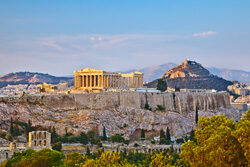Athens tourist information.
 Named for Athena, the Greek goddess of wisdom and courage, Athens has been the center of Greek civilization for some 4,000 years. The capital of modern Greece, it’s still dominated by 5th-century-B.C.E. landmarks, including the Acropolis, a hilltop citadel topped with ancient buildings such as the colonnaded Parthenon temple. But it’s also a contemporary city, and it’s not uncommon for the nightlife hubs of Kolonaki, Psiri and Gazi to stay busy until dawn.
Named for Athena, the Greek goddess of wisdom and courage, Athens has been the center of Greek civilization for some 4,000 years. The capital of modern Greece, it’s still dominated by 5th-century-B.C.E. landmarks, including the Acropolis, a hilltop citadel topped with ancient buildings such as the colonnaded Parthenon temple. But it’s also a contemporary city, and it’s not uncommon for the nightlife hubs of Kolonaki, Psiri and Gazi to stay busy until dawn.
Athens boasts one of the most happening nightlife scenes in Europe, which now centres on the urban-chic bars and cafés between Syntagma and grungy Monastiraki (at the foot of the Acropolis), and the up-and-coming neighbourhood of Metaxourgiou, known for its art galleries and hip eateries.
The cruise port of Piraeus
Athens is served by Piraeus, the largest passenger port in Europe and the major node for the countless ferries, catamarans and hydrofoils that serve the Greek islands. The port has 11 modern berths for cruise ships. The Port of Piraeus is on the southern edge of the city, on the Saronic Gulf coastline (part of the Aegean Sea). The port is first and foremost a ferry terminus, serving the Greek Islands. Greece has many islands, so ferries are essential and sail in and out of Piraeus 24 hours a day.
The cruise ship berths are on the quays to the southern side of the port. Cruise ships moor at Cruise Terminal A or Cruise Terminal B. Cruise Terminal A (Miaoulis), approached by entrance E11, is located in the middle of the harbor between the Mioulis and Xaveris docks. Cruise Terminal B (Themistocles), approached by gate E12, sits at the entrance of the harbor, inside the Termistokleous breakwater.
The Acropolis and Parthenon
The Acropolis hill, so called the “Sacred Rock” of Athens, is the most important site of the city and constitutes one of the most recognizable monuments of the world. It is the most significant reference point of ancient Greek culture, as well as the symbol of the city of Athens itself as it represent the apogee of artistic development in the 5th century BC.
On the rock of Acropolis there are several monuments from the Greek Antiquity , most of the monuments was build on the Prehistoric temples of the Sacred rock during the golden age of Pericles of Athens during the 5th century BC.
Among those monuments of the Acropolis, Parthenon is the most magnificent. The Parthenon is a former temple on the Athenian Acropolis, Greece, dedicated to the goddess Athena, whom the people of Athens considered their patron. Construction began in 447 BC when the Athenian Empire was at the peak of its power.